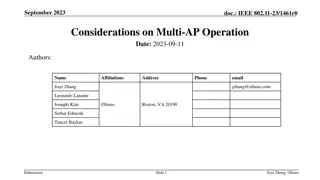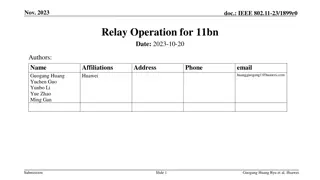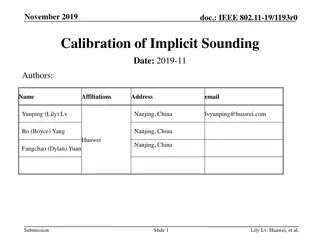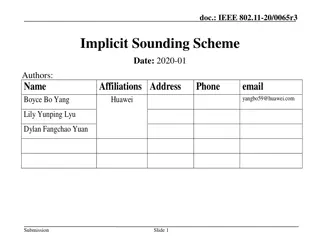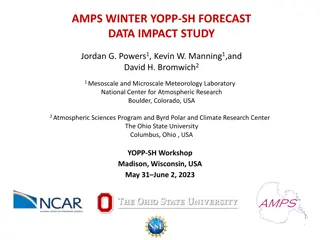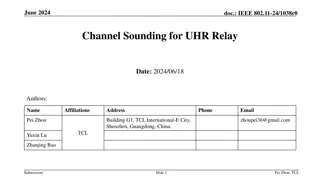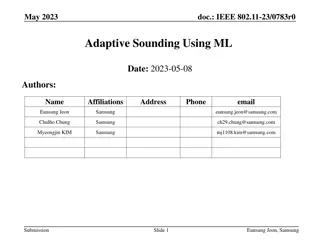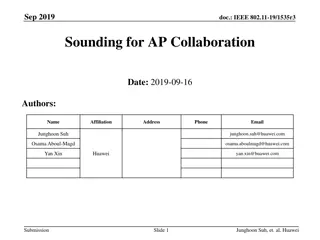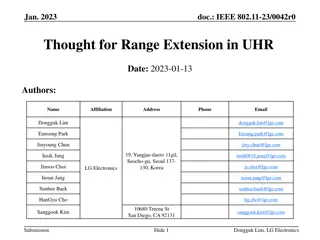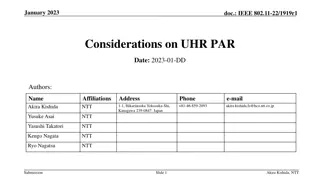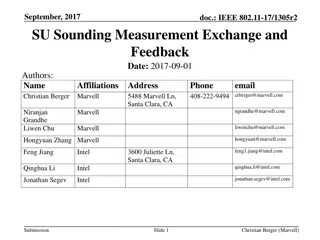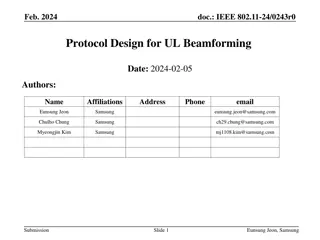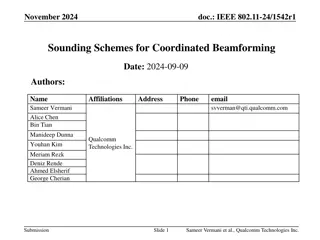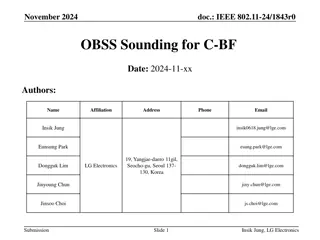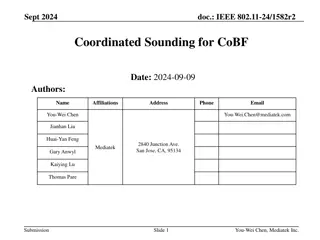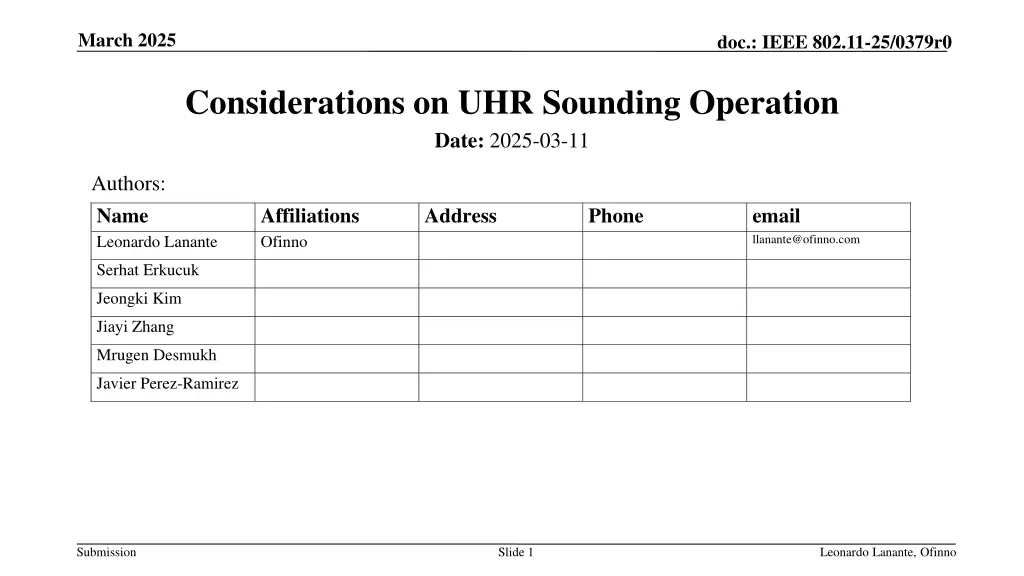
UHR Sounding Operation Considerations for IEEE 802.11-25/0379r0
Explore the considerations and proposals for Ultra-High Rate (UHR) sounding operations in IEEE 802.11 networks as outlined in the March 2025 document. The document discusses issues, solutions, and protocol sequences related to UHR sounding in Cooperative Beamforming (CoBF) scenarios.
Download Presentation

Please find below an Image/Link to download the presentation.
The content on the website is provided AS IS for your information and personal use only. It may not be sold, licensed, or shared on other websites without obtaining consent from the author. If you encounter any issues during the download, it is possible that the publisher has removed the file from their server.
You are allowed to download the files provided on this website for personal or commercial use, subject to the condition that they are used lawfully. All files are the property of their respective owners.
The content on the website is provided AS IS for your information and personal use only. It may not be sold, licensed, or shared on other websites without obtaining consent from the author.
E N D
Presentation Transcript
March 2025 doc.: IEEE 802.11-25/0379r0 Considerations on UHR Sounding Operation Date: 2025-03-11 Authors: Name Leonardo Lanante Affiliations Ofinno Address Phone email llanante@ofinno.com Serhat Erkucuk Jeongki Kim Jiayi Zhang Mrugen Desmukh Javier Perez-Ramirez Submission Slide 1 Leonardo Lanante, Ofinno
March 2025 doc.: IEEE 802.11-25/0379r0 Introduction There are two possible sounding sequences for COBF in UHR Sequential NDP based sounding Joint NDP based sounding In both sounding sequences, 2 APs initiate sounding sequences until all necessary CSI feedback are obtained. total four sequences for sequential NDP based sounding total two sequences for joint NDP based sounding In this contribution, we discuss 2 possible issues that may occur during the CoBF channel sounding and propose solutions. Submission Slide 2 Leonardo Lanante, Ofinno
March 2025 doc.: IEEE 802.11-25/0379r0 UHR Sounding Protocol sequences (1/2) UHR defines two sounding sequences to support DL CoBF. The first is a sequential NDP sounding sequence and the second is a joint NDP sounding sequence. EHT Sounding NDP UHR NDP Announce ment UHR NDP Announce ment BFRP Trigger BFRP Trigger AP 1 EHT Sounding NDP AP 2 Compressed Beamforming/ CQI Compressed Beamforming/ CQI STA 1 UHR TB Sequential NDP sounding sequence initiated by AP 1 EHT Sounding NDP UHR NDP Announce ment BFRP Trigger AP 1 EHT Sounding NDP AP 2 Compressed Beamforming/ CQI STA 1 UHR TB Joint NDP sounding sequence initiated by AP 1 Submission Slide 3 Leonardo Lanante, Ofinno
March 2025 doc.: IEEE 802.11-25/0379r0 UHR Sounding Protocol sequences (2/2) To collect the channel state for CoBF transmission, each AP needs to initiate a sounding sequence. Only after both APs successfully perform sounding can CoBF transmission can start. total sounding duration CoBF PPDU CoBF PPDU CoBF Trigger AP 1 AP2 initiated sounding sequence AP1 initiated sounding sequence CoBF PPDU CoBF Trigger CoBF PPDU AP 2 AP1 initiated sounding sequence(s) AP2 initiated sounding sequence(s) STA 1 STA 2 sounding interval Submission Slide 4 Leonardo Lanante, Ofinno
March 2025 doc.: IEEE 802.11-25/0379r0 Problem 1 In some scenarios, the total sounding duration for CoBF sounding may be prohibitively long. For example, if the other AP is not able to obtain a TXOP due to channel being busy. This may lead to insufficient during CoBF as the channel may have changed since the start of the sounding. total sounding duration AP 1 Channel busy AP 2 AP1 initiated sounding sequence(s) AP2 initiated sounding sequence(s) STA 1 STA 2 Submission Slide 5 Leonardo Lanante, Ofinno
March 2025 doc.: IEEE 802.11-25/0379r0 Proposal To prevent the problem, we propose to define a mechanism for truncating the CoBF sounding operation by either AP. Truncating the UHR sounding protocol allows AP1 to re-use existing CSI feedback in a non-CoBF PPDU before the CSI expires. Option 1: Either of the APs transmit a sounding termination notification frame to the other AP. Option 2: Sounding is terminated automatically after a timeout interval (e.g., starting from the end of the AP1 initiated sounding sequence(s)) total sounding duration (1) Sounding termination notification AP 1 Channel busy AP 2 AP1 initiated sounding sequence(s) AP2 initiated sounding sequence(s) STA 1 STA 2 (2) Timeout interval Submission Slide 6 Leonardo Lanante, Ofinno
March 2025 doc.: IEEE 802.11-25/0379r0 Problem 2 During UHR TB joint NDP sounding or cross-BSS UHR TB sounding, the responding AP is expected to overhear the CSI feedback solicited by the initiating AP. In case of reception error by the overhearing AP (e.g., incorrect link parameters), CoBF can not be performed until the next sounding interval. UHR NDP Announce ment EHT Sounding NDP BFRP Trigger Non-COBF PPDU Success Success Invite AP 1 EHT Sounding NDP CoBF PPDU Respon se No Success Fail AP 2 Compressed Beamforming/ CQI STA 1 STA 2 AP1 initiated sounding sequence(s) AP2 initiated sounding sequence(s) Submission Slide 7 Leonardo Lanante, Ofinno
March 2025 doc.: IEEE 802.11-25/0379r0 Proposal To solve the problem, we propose a CSI reception report mechanism for the responding AP. The report may be transmitted by the responding AP on its own using its own TXOP. Or may be solicited by the initiating AP (e.g. using a trigger frame). If the CSI reception report indicates failure, the initiating AP can perform one of the following Retransmit the BFRP trigger frame Reinitiate the sounding sequence that contains error. Forward the CSI feedback to the responding AP (if available). UHR NDP Announce ment EHT Sounding NDP BFRP Trigger BFRP Trigger Success AP 1 EHT Sounding NDP CSI Success Fail reception report (error) AP 2 Compressed Beamforming/ CQI Compressed Beamforming/ CQI STA 1 STA 2 AP1 initiated sounding sequence(s) Submission Slide 8 Leonardo Lanante, Ofinno
March 2025 doc.: IEEE 802.11-25/0379r0 Conclusion Errors may occur when two APs perform CoBF sounding sequences. Due to the inherent time constraints involved with the CSI feedback during CoBF sounding, we proposed to define mechanisms to 1) Truncate the CoBF sounding procedure. 2) Report CSI feedback reception error by the responding AP. Submission Slide 9 Leonardo Lanante, Ofinno
March 2025 doc.: IEEE 802.11-25/0379r0 Strawpoll 1 Do you agree to add in the 11bn specification: 11bn defines a mechanism to truncate the UHR sounding protocol sequences initiated by an AP. The detailed mechanism is TBD. Submission Slide 10 Leonardo Lanante, Ofinno
March 2025 doc.: IEEE 802.11-25/0379r0 Strawpoll 2 Do you agree to add in the 11bn specification: 11bn defines a mechanism for an AP to report its CSI feedback reception status after a UHR TB sounding sequence initiated by another AP. The detailed mechanism is TBD. Submission Slide 11 Leonardo Lanante, Ofinno


